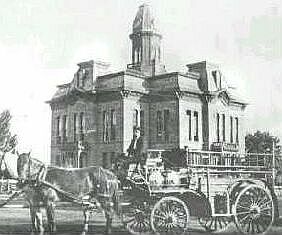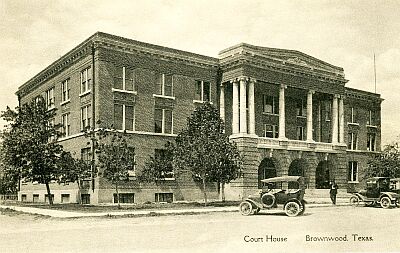|
By Judge Frank Griffin The history of the Courthouses of Brown County is more than just the history of the physical buildings that have housed the courts and offices of government in Brown County. Each of the courthouses that has served Brown County is a reflection of the times and needs of the people of Brown County. The first recorded session of government in Brown County was held in the home of Welcome W. Chandler. Chandler had built a two story log house on the east bank of the Pecan Bayou in 1857. Welcome Chandler presided as the first judge, but declined to be elected as County Judge. FIRST COURTHOUSE In pioneer Texas, the Courthouse was a symbol of civilization. More than that, however, it was a refuge in the wilderness. The Courthouse was where the settlers came to hear news, to buy, sell, and trade, and to pick up the occasional mail. Even more important, the Courthouse was usually a semi-fortress. It was the refuge to which all came in the event of an Indian raid. The first courthouse was built on the Chandler farm in 1858. It was a single story, 16 X 18 log structure built of logs harvested from the nearby Pecan Bayou. The courthouse was seated with split log benches. Ichabod Adams donated a rawhide bottom chair for the use of the judge. The papers, records, and other items of importance were kept in a flour sack. SECOND COURTHOUSE The first site of the Courthouse did not have a reliable source of good water. Therefore, it was moved, log by log, to the Connell farm in 1859. The Masons added a second floor to use as a Masonic Lodge. This courthouse was located on the East side of the Pecan Bayou. The first recorded session of court was held in this courthouse. The jury panel camped out around the courthouse, and the judge and lawyers stayed at the house of Billy Connell, which was about 300 yards away. Court was held in the log building, but the lawyers met with their clients under the trees on the banks of the slough, and the jury deliberated under a large oak tree on the banks of the slough. While the jury was in session, target practice in the direction of the slough was suspended by general consent. THIRD COURTHOUSE At some time around 1870, the Courthouse was moved from the East
side of the Bayou to land donated by Greenleaf Fisk on the West side.
The log courthouse was once again disassembled and moved, but the puncheon
floors were replaced with sawn planks.
The 1870’s were a lawless time. Reconstruction after the Civil War caused a breakdown in law and order. In 1874, one resident recalled that the window shutters of the old courthouse were shot up by cowboys shooting up the town and the old logs were full of lead. FOURTH COURTHOUSE By the mid 1870’s, the Indian menace was nearly over. Reconstruction was over; Brown County was no longer on the frontier. The population of the county was rapidly increasing with new settlers. The citizens recognized the need for a new and larger courthouse. In 1876 the citizens of Brown County approved bonds for a new courthouse. It was completed in January or February of 1877. It was two stories, and was 22 ½ feet by 42 ½ feet. The jail was on the first floor and the courtroom was on the second floor. This courthouse was burned by arson on March 29, 1880. Courthouse arson was, unfortunately, common during this time period, and was often used to destroy evidence of land fraud or crime. For many years after the Brown County Courthouse burned, citizens speculated that it was burned to destroy evidence of a grand jury indictment of a prominent citizen. The Courthouse was repaired in 1881, and at the same time the jail was removed to a separate building. Very soon, this building was also found to be too small for the growing population of the county. FIFTH COURTHOUSE
The citizens of Brown County voted in 1884 to build another courthouse. The Courthouse was completed on February 15, 1885. It was a two story structure made of native sandstone with a clock tower. No clock was ever installed. This Courthouse was constructed much like the still standing old jail. By 1915 many citizens again felt the courthouse should be replaced. Others, especially those in the rural areas, did not want additional taxes for any reason other than to improve roads and bridges. In October of that year, the Grand Jury reported that they objected to bats, mice, and roaches in the jury room, the filthy rest rooms, and general crowded conditions. County commissioners considered a $200,000.00 new courthouse, but then
announced that they were discarding that idea and would remodel the old
courthouse. By the time the opposition realized what was happening,
the old courthouse was demolished, except for a few walls that were incorporated
into the “renovations”. The “repair” project which resulted in the courthouse located at 200 S. Broadway, was completed on September 9, 1918. It has been in continuous use since that date. That in itself is remarkable. When the courthouse was built, it was wired for electric lighting. However, no wall plugs were included for electronic devices, as none existed at the time. It has gone from the dawn of the 20th century to the dawn of the 21st. It operates under conditions never foreseen in 1918, dealing with issues such as security, handicapped access, sufficient electricity, and houses County agencies and functions that simply did not exist when it was built. SIXTH BROWN COUNTY COURTHOUSE
The Courthouse that will take Brown County through the 21st century
and into the 22nd will be wired for an array of electronics that was beyond
the imagining of the people who built this present facility. It will
be secure against the threats of terrorism, both domestic and foreign.
It will be a facility that will represent the accomplishments, hopes, and
dreams of the people of Brown County. It will serve our needs just
as the first five have.
The Burning of the Courthouse and Jail in 1880 |

 You can see these walls today in the Treasurers office and the Commissioner’s
Courtroom.
You can see these walls today in the Treasurers office and the Commissioner’s
Courtroom.
 Some
day, perhaps soon, perhaps not so soon, the Commissioners Court of Brown
County will have to make a decision concerning the next Brown County Courthouse.
They will face opposition from those who believe the primary function of
the County government is to repair roads and bridges. They will have
to deal with those who want to build an extravagant facility. They
will have to build for functions and needs that we can’t even foresee.
Some
day, perhaps soon, perhaps not so soon, the Commissioners Court of Brown
County will have to make a decision concerning the next Brown County Courthouse.
They will face opposition from those who believe the primary function of
the County government is to repair roads and bridges. They will have
to deal with those who want to build an extravagant facility. They
will have to build for functions and needs that we can’t even foresee.